D
Deleted member 73526
Guest
It depends. How much do they weigh?Would it be prudent to get the latest GPX tracks for the stretch between Requejo and Lubián?

| Remove ads on the forum by becoming a donating member. More here. |
|---|
It depends. How much do they weigh?Would it be prudent to get the latest GPX tracks for the stretch between Requejo and Lubián?
I think this is one of those individual choices that just depend on personal comfort level. Last year, when I walked the Vasco/Olvidado/Invierno, I did not bring tracks for the Invierno. When I walk with a GPS I play a little game of sorts. Only look at it if I’m at an unmarked intersection or if I’ve been going for what seems like a long time without an arrow. I never hold it in my hand as I walk, but keep it in the pocket on the side of my pack. Even with that limited use of GPS, it did build a sense of comfort/assurance that I lost when I started the Invierno. Even though the Invierno is probably the most marked camino in Spain, not having access to the GPS took some mental re-adjustment. I guess I made the “no-GPS” decision for the Invierno just to prove something to myself — and thinking about it, it’s probably because walking caminos alone has been a tremendous source of a sense of self-confidence for me, so maybe I was just wanting to push that a bit.Would it be prudent to get the latest GPX tracks for the stretch between Requejo and Lubián? And beyond, judging from @Albertagirl 's experience in 2017?
I use my phone to display the GPX tracks, and like you, use it to check directions when in doubt.When I walk with a GPS I play a little game of sorts. Only look at it if I’m at an unmarked intersection or if I’ve been going for what seems like a long time without an arrow.
The ascent to the border with Galicia at Porto Canda is one of those beautiful green tunnel walks. I noticed the immediate appearance of cow poop as soon as I started down on the other side, so we are definitely in Galicia.
I don't think many pilgrims stop in Vilavella
A gawjuss stage. I’m sure I’ve mentioned in the other virtual Camino that the sense of arrival in Galicia at the Portelo da Canda is just wonderful.Day 56: Lubián to ... Vilavella
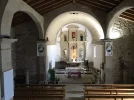
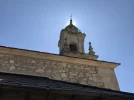
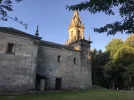


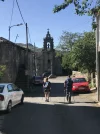
A gastronomer? Is that when the moon hits your eye like a big pizza pie?EDIT: and a foodie! I meant: a gastronomer! ☺
And now AJ, you have to add stand-up comedian to your list.A gastronomer? Is that when the moon hits your eye like a big pizza pie?
On this stretch you also have Hostal Porta Galega up above the village of Vilavella on N-525 (just a little bit past petrol stations on both sides of the road). Slept there two years ago and it was pretty nice vs. price. Restaurant too.Day 57: Vilavella to A Gudiña
I quite like the idea of walking a bit further than Vilavella, and staying at Hotel Cazador in O Pereiro Novo, as suggested by @Raggy . The walk from Lubián to Laza would then be in three stages: Lubián to Hotel Cazador (15km), then to Venda da Bolaño (22km), and finally to Laza (22km).
We have no deadlines, as mentioned before, and we might still take 4 days to walk to Laza from Lubián. So this could be a short stage to A Gudiña, just 13km. Unless my darling is full of energy!
We're open to suggestions for accommodation in A Gudiña.
On this stretch you also have Hostal Porta Galega up above the village of Vilavella on N-525 (just a little bit past petrol stations on both sides of the road). Slept there two years ago and it was pretty nice vs. price. Restaurant too.
Google Maps still showing me Youth Hostel even higher above the Vilavella (at the train station) but same info was given to me both in 2015 & 2018 - they closed it exactly because of the remote location. Don't know the situation right now.
A bit further on the Camino after Vilavella where you cross OU-311 (O Pereiro do Abaixo) you can turn sharp right and there is roadside (on N-525) motel O Carrizo. I slept there in 2015 for 15€ with shared bathroom. Excellent food for the price. Overall pretty good option if you don't mind a bunch of truck drivers. And they accept credit cards
There's a dramatic change of scenery from Vilavella, from dense forest to wide open heath. The path under foot is comfortable to walk on and generally flatter and wider than the climb and descent into Galicia. Last time I was there, I felt my pace increase as though someone had replaced my boots with skates. It's very pretty until the last couple of kilometers when you cross over the Autovia and then walk along the N525 into A Gudiña.Day 57: Vilavella to A Gudiña
Raggy, your description of the bakery started me trembling for freshly baked bread! Torture that people from the US are not allowed over there!!!!Yes. You've left the Tierra del Vino for the Tierra del Pan. And if you leave Zamora nice and early, there's an appropriate treat for you in the first town after Zamora - Roales del Pan:
The relatively recently established bakery "Panificador Alberto," is on a side road to the left of the Main Street. The delicious smell of freshly baked bread will leave you in no doubt about which street. It looks like the kind of business that must have been there forever, but I don't remember seeing it when I walked through in 2017. You can see on Google Streetview that it's a derelict building in the older images.
It doesn't look like a shop that you can walk into and buy bread from - I think they must deliver most of their bread to local businesses and individuals - but they're quite happy for pilgrims to drop by and pay for some purchases at the office. No better mid-morning snack than a still warm loaf on the edge of a field. If you picked up some cheese in Zamora you'll have a feast.
The roads are straight and the landscape undramatic but not unpleasant. I stayed at at the albergue in Montamarta, which was a clean, unattended, building a little out of the town. It had two good showers, a kitchen with basic equipment, a washing machine, a line for drying clothes outside, and a barbecue area. I don't think anyone showed up to check in on us. If I recall correctly, we just left the requested payment in a box and entered our own details in the register. We ate at Rosamary's. I don't remember it as remarkable - perhaps a cut above the average pilgrim menu. There's a supermarket between the albergue and Meson Rosamary, where we bought food for breakfast.
If you push on further than Montamarta, there is a newly opened albergue at Fontanillas de Castro. In 2017, I stayed in the village sports hall. It's a very small community with basically one roadside restaurant. Not much going on there, but it's worth knowing as an option.
BTW.- You'll see a bronze statue of El Zangarron by the church - a colorful part of the local folklore:

Zangarrón de Montamarta (1 de enero del 2019)
Zangarrón de Montamarta (1 de enero del 2019)www.laopiniondezamora.es
For the first time since March, I found yeast in my local grocery store yesterday and bought a bottle, If you buy some yeast and are willing to work at it, you can make your own fresh bread. Very tasty!Raggy, your description of the bakery started me trembling for freshly baked bread! Torture that people from the US are not allowed over there!!!!
Oh you don't know how I have tried for many decades to make raised dough baked goods. One time a friend and I made the same recipe side by side--his came out just right and mine was like a rock!For the first time since March, I found yeast in my local grocery store yesterday and bought a bottle, If you buy some yeast and are willing to work at it, you can make your own fresh bread. Very tasty!
Given that I am still stuck behind closed borders in Australia, with no opening in sight this year, I'll gladly do a virtual Camino Levante with @KinkyOne .I was hoping you would jump in here K1! And just to point out to @AJ, that if K1 is around, a virtual Camino Levante would be a lot of fun.
I have never walked the alternative route through Verín and Allariz, but I have visited Allariz and its nearby Santa Mariña de Aguas Santas and HIGHLY recommend that visit. Roman ruins, the site of Santa Mariña’s martyrdom, and hill forts also right there to visit. So you will have a choice to make once you are in A Gudiña.
Almost everybody seems to take the Laza route out of A Gudiña, presumably because it's a day or so shorter, but the Verín way is good too. Verín itself is a bustling friendly border town with a great dominating mediaeval hill-top fortress and some decent restaurants. The largely empty albergues on the way are outstanding - last November I was about the 125th person of 2019 to stay in the very well equipped and clean albergues of Villaderei and Xinzo de Limia. And, as Laurie also says, Santa Mariña is well worth a visit, and only 500m off the camino.
In the old town center you will see arrows pointing in two directions - right for the route through Laza and left for the route through Verin (which is the longer way to go). I don't think many people opt for the Verin route.
Day 58: A Gudiña to Venda da Bolaño or CampobecerrosThe old town center (A Gudiña) has banks, pharmacies, a bakery, supermarkets and other shops. This is the last proper town that you'll pass through until Laza, so you'd better get anything you need here. The bakery is in the old town center, and opens early so you can get fresh bread before heading off toward Campobecerros or Venda da Bolaño.
Day 58: A Gudiña to Venda da Bolaño or Campobecerros
Much of the stage is on asphalt, but there is very little traffic and the scenery makes up for the hard surface. I hadn't thought of the weather as a deciding factor but Peregrina2000 is right that the steep descent into Campobecerros on that flaky, shale, surface is a bit hairy, even in dry weather.Day 58: A Gudiña to Venda da Bolaño or Campobecerros
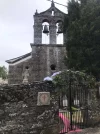
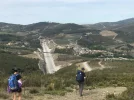

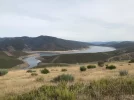
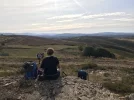
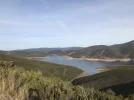
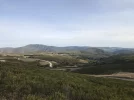
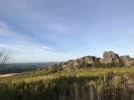
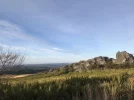
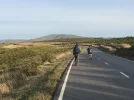
In Campobecerros you can buy basic groceries in mentioned bar which is connected to Albergue da Rosario (same owner)....
With this in mind ... If I were to stay in Campo again, I might have dinner at the first bar that you pass on the way into town. There's no kitchen in the albergue and I don't think that there is a shop in Campobecerros, but I think that there might be a barbecue in the albergue garden in the warmer months. so perhaps it's possible to bring food for the grill from A Gudiña. You should probably call ahead to confirm the existence of a barbecue before doing that - just to be sure that it can be done.
There is nothing open in Campobecerros in the morning and no commercial activity in the villages before Laza, so you should buy something to enjoy for breakfast before you go to bed. I'm sure that any of the bars will whip up a bocadillo for you.
[.yhw wonk t'nod I .redro esrever ni deyalpsid era sotohp s'yadoT]
Cool. I didn't know that there was a bar there. I appreciated the donativo punto de apoyo, though.There is a donativo stand and a bar (not always opened) in the last village before Laza. Young guy on the right in the photo is the owner. Extremely welcoming.
Even cold beer in 2015Cool. I didn't know that there was a bar there. I appreciated the donativo punto de apoyo, though.
First time I walked through (Nov 2017), I think there was cold coffee and some snacks, for which I was grateful. Second time, there were richer pickings.
I had thought that Venda da Bolaño might not be available for one-night stays, and also that I would have to hire a whole apartment. I did a quick check here, and they have a requirement for a minimum of two nights.If you are thinking of making a stop at Venda da Bolaño, I'd suggest speaking to the owners (or checking whatever booking engines they. may use) to confirm that they're OK with a one-night stay. I would guess that they are. You might also ask what they can do to provision the kitchen for your evening meal. It might transpire that you need to carry food from A Gudiña.... but it's also possible that they'll leave you a dish to warm up. I would be interested to know what kind of welcome they offer. Waking up with a view of the surrounding valleys from that isolated settlement would be a treat, I think.
There's at least two taxi drivers in A Gudiña, according to Google, so if need be, we could shorten the walk to Campobecerros by taking a lift for the first few kilometres.I didn't want to walk the whole distance to Laza from A Gudina so twice now I have taken a taxi in the morning to the 3rd Venda and then after second breakfast in Campobecerros I walked to Laza. A long day but enjoyable.
Had we stayed in Venda da Bolaño, we would indeed have called the taxi from Laza, probably after As Eiras.It would be cheaper if you call the taxi from Laza on the Campobecerros-Laza stage because it's much closer. I'm sure there is one because I saw a flyer or a poster either in Albergue da Rosario or somewhere very close on the street lamp post in 2018.
As @Raggy mentioned, the alternative is the Pensión Blanco Conde.You could stay at the hotel, but the albergue is not far from the town center and it's a pretty good one - a big, municipal affair with multiple dorms for eight people each. It has male and female shower rooms with two showers each and basins for washing clothes. There are washing lines in the central yard, a good kitchen, and a large dining / social area.
The restaurant upstairs opens at 7:30, I think. 10 Euros gets you the pilgrim menu - Three courses with a lot of choices. All good, homemade dishes. Included in the menu is a drink (which if you order wine, means a full bottle). And the service is super-friendly and completely honest. I remember the waitress telling me: "The flan isn't home made flan, but it's a very good one. You won't be disappointed." She was right. I would rate this menu peregrino as the second best on the Sanabres.
Not really true. It's kind of on the edge of the old part of town but certainly not far from anything you might need. If you walk on the Camino the next day towards Vilar de Barrio from albergue you will have to walk past many more houses to the "out of town"...
In Laza, Gronze indicates that the Albergue de peregrinos de Laza is "a las afueras", out of town.
...
It's possible that the owners would be open to a single night stay if you called ahead, but probably best to assume that it's not an option.I had thought that Venda da Bolaño might not be available for one-night stays, and also that I would have to hire a whole apartment. I did a quick check here, and they have a requirement for a minimum of two nights.
I guess you wouldn't lose too much by taking a taxi up the hill as far as the turnoff to the Vendas. The scenery for that stretch is quite nice but it gets better later on.There's at least two taxi drivers in A Gudiña, according to Google, so if need be, we could shorten the walk to Campobecerros by taking a lift for the first few kilometres.
Another stage with quite a lot of asphalt at first - winding through little villages - and some pleasant footpaths with babbling brooks later on ... Definitely get the feeling that you're coming out of the mountains and entering a tamer kind of countryside. Last year I saw a posh house under construction near the punto de ayuda that Kinky mentioned earlier, and now I know that there is occasionally a bar there too, so I guess there's still some life left in these settlements. When I walked through in 2019, I had the feeling that they were all but abandoned.Day 59: Campobecerros to Laza



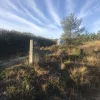
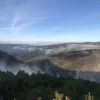
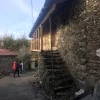
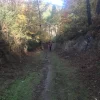
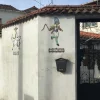
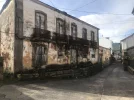
Definitely recommend the dinner at A Picota. I have a feeling that people would be talking it up as special if it weren't for the exceptional Me Gusta Comer in Rionegro.
Not sure that we would manage to plan to be there precisely when they have the pulpo event mentioned by @peregrina2000.experience fine dining as it was fifty years ago.
When I stopped there for a snack in mid-November of 2017, I mentioned that I was a Canadian and he immediately put on a recording by Leonard Cohen, who had died the previous November. and who had been a major voice in Canadian folk music for most of my life. It was one of those things that happen on camino.I particularly loved the reference to Luis playing oldies on his sound system in Alberguería
I also noticed that the albergue in Albergueria was not listed in Gronze. I expect it to reopen, though. How else will Luis recoup the costs of the improvements? He is very devoted to the Camino and the pilgrims who walk it, and he might play some of your favourite music if he has it, but don’t expect a lively conversation. He’s a man of few words. if you stay in Albergueria, you will make your own dinner in the albergue kitchen. It has a stock of pasta, dehydrated soup, and tinned tomatoes, tinned fish etc. Luis can sell you ham, eggs, cheese, more tinned fish, and bread. It wouldn’t be a bad idea to carry an ingredient or two from Laza - fresh fruit or veg. for instance.Day 60: Laza to Vilar de Barrio
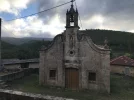
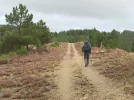
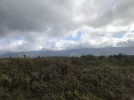
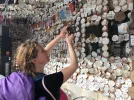
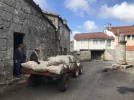
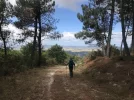
Did you stay there, @KinkyOne ?On this stage (on the descend from Albergueria) is apparently one more option for overnight stay although it was all quiet there in 2018:
Nope. It looked inhabited but with nobody around at the time I was passing by. It's just a short and way-marked detour from official Camino. There are still some ruins. It looked like little hamlet or bigger farm secluded in the forest. A little bit along the way from it (30 meters maybe) the oldest/widest (???, don't remember anymore) tree in Galicia was advertised.Did you stay there, @KinkyOne ?
And we have made a note to stop atUnless you're trying to save every Euro you can, my recommendation is to continue past the municipal albergue into the town center to stay at the private albergue - Casa Tomas. The location alone is worth the extra seven or eight euros. The owners are lovely people
for breakfast. Pains au chocolat! ☺Bar Copas, which is just a couple of hundred meters across the square. There you will find good coffee, toast, freshly baked croissants, pains au chocolat, (probably other things too), and friendly service.
After you leave Albergueria, you'll come across a crucifix which, I think, is dedicated to pilgrims who lost their lives on the camino. I might be wrong about that ... hope someone will correct me. Following that, you will come across an intriguing invitation to take a detour to see some abandoned houses and a very old tree. The tree is rather hard to find without measuring distances and checking GPS but very worthwhile. (be careful there is a fork in the road by the sign and you don't want to go down the wrong one. If things get overgrown, turn back to the sign and see if there isn't an easier way to go).Day 61: Alberguería (or Vilar de Barrio) to Xunqueira de Ambía
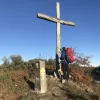
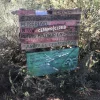


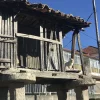
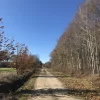
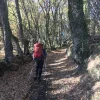
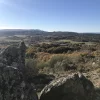
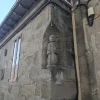
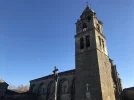
Absolutely no problem to find it. As I already mentioned above it's well way-marked. Anyway here's my track from 2018: https://www.wikiloc.com/hiking-trails/camino-sanabres-albergueria-villar-de-barrio-24816302 (use OpenStreetMap view to see the track, at least I have to). Zoom in until you can see sharp left turn off the OU-113 to O Veredo.... you will come across an intriguing invitation to take a detour to see some abandoned houses and a very old tree. The tree is rather hard to find without measuring distances and checking GPS but very worthwhile. (be careful there is a fork in the road by the sign and you don't want to go down the wrong one. If things get overgrown, turn back to the sign and see if there isn't an easier way to go).
...
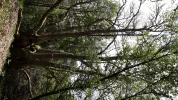
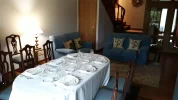
I agree, it's similar situation as coming to Burgos - industrial suburb vs. river walk. But it's not hard to find it. Here's my track from 2015: https://www.endomondo.com/users/16690154/workouts/570530284...
Unfortunately, there's a big, ugly, industrial estate between Xunqueira and Ourense. So you need to do some planning here. I hope that someone will offer you guidance about the river route - a route that takes you around the worst of the industrial estate. I wish I had done that.
...
Huh, I wouldn't know because we came there very late and didn't ask much about using their facilities. But I also don't remember anyone eating/cooking there that evening...The photo of the dining room at Casa de Souto struck me as much too civilized to have been anywhere that I stayed on that camino. I shall have to look for it on my next time through (after the Levante). That is, if I think that I coulld get a vegetarian meal there, as it looks more like a family dining room, likely to have minimal choices at the meal. Perhaps a phone call to ask in advance?
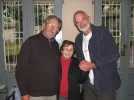
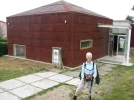
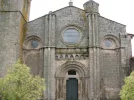
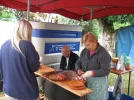
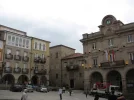
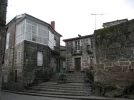
Well, I did not find it straightforward to find the tree in 2017 and to my surprise, I found it difficult again in 2019. So perhaps the way marking works for some and not others.Absolutely no problem to find it. As I already mentioned above it's well way-marked.
Hahaha, I was there in 2018, right between your two visitsWell, I did not find it straightforward to find the tree in 2017 and to my surprise, I found it difficult again in 2019. So perhaps the way marking works for some and not others.
Great detail memory @KinkyOneHahaha, I was there in 2018, right between your two visits
I don't remember the tree was clearly marked but the route was (see my GPS track). It is located (the tree) some 30 meters after the last O Veredo ruined house approximately 20 meters from the path (a bit downhill) to the left if my memory serves me still. And I do have kind of a photo memory
Ahhh, might be a bit more than 30 meters down the trail but I can't open the map big enough (post no.123) to see the distance. Anyway, I hope it is still thereGreat detail memory @KinkyOne
But some days seem to etch themselves more than others. I find that if you also take photos (as you did) and look at them from time to time - the memory is even more reinforced.
Laurie is another one that can recall details and experiences ; almost to the minute. Very impressive.
Exactly what I wrote if you read carefully but also my English could be a little bit "clumsy" sometimes... but we seem to agree that one needs to be aware that the tree is a certain distance down the path (as indicated by the sign) and then a certain distance off the path (to the left).
...
Just wondering if anyone else ate in the house where the woman in the first picture prepared a meal in Vilar de Barrio. I don’t think it was a proper restaurant, but maybe I am misremembering. Fourth picture is the pulpo stand in the same town. Second picture is the albergue in Xunqueira, which looks kind of like a rusty tin can. The one below is the church, well worth a visit, and the last two are of the town, which is pretty.
My only regret, oft repeated when Xunqueira comes up, is that the Bocatería Bejé has closed. I ate there twice and had great meals both times. It was a small place, run by two local women who lost their jobs at a factory nearby and decided to open up a restaurant. It was on the main road from the albergue into town. But a forum member informed me a few years ago that it has closed.
And I wonder if anyone remembers meeting an elderly resident living right behind the albergue in Xunqueira. He had chickens, a nice garden, and was very friendly. He was so excited to practice his French (having worked there post-Civil War) with my two companions in 2013, and I realize that was many years ago now!
Was it a place with a blue door? If so, then I think that's who fed the pilgrims that I met, when they found themselves stuck without any way to buy food.Yes,Laurie, in 2013 a friend and I ate at the lady's house opposite the Albergue in Vilar de Barrio.
So much good food that kept coming.There was no menu. We were full but didn't want to insult her by leaving any. Wonder if she is still there ?
Can't remember if the door was blue or not,sorry.Was it a place with a blue door? If so, then I think that's who fed the pilgrims that I met, when they found themselves stuck without any way to buy food.
And it's taken us longer than most...At Xunqueira, you are one stage from Ourense, the official 100km point at which many people start their Caminos. Amazing to think that it's taken us this long to get to the place where people start. isn't it?
I assume you're referring to the industrial estate around A Castellana and A Zamorana.Unfortunately, there's a big, ugly, industrial estate between Xunqueira and Ourense. So you need to do some planning here. I hope that someone will offer you guidance about the river route - a route that takes you around the worst of the industrial estate. I wish I had done that.
Strap on an N95 mask and tread carefully around the puddles of oily water.
It is tempting to go to Allariz. It is after all on the alternative Sanabrés via Vérin. Then we could walk from Allariz to Ourense, and still experience Seixalbo. So this is what we are going to do: walk to Allariz, or even further to Taboadela. Depending on which route we take to Allariz, this would be a 14km to 16.5km walk. Then on to Ourense.There are buses from Allariz to Ourense - so one option would be to walk to Allariz, then catch a bus. By doing that, you would miss Seixalbo, which is a pretty exurb of Ourense. I guess that's not a bad option actually, since Seixalbo is just a couple of streets. Allariz is supposed to be historic and pretty.



On the other hand, @Raggy does list quite a few things to do and see.I have always found Ourense to be a kind of depressing little city. But the portico on the cathedral (The Pórtico del Paraíso) is from the workshop of Maestro Mateo, who did the Pórtico de la Gloria in Santiago. The painting on the portico was recovered about 10 years ago by removing all the dust and grime. The painting appears to be from the barroque period rather than the original late romanesque. I had a long conversation with a priest there who told me he accepted the scientific findings that the painting was from the 18th century, but as keeper of the cathedral records, which go back to the 17th century and detail every bit of official action and expenditure, the lack of any mention of the painting project leads him to wonder if the painting is actually much older. But whatever century it is from, it is really lovely.
Thank you @KinkyOne . The intention is to actually walk from Allariz to Ourense, but I am getting ahead of myself ☺The bus from Allariz to Ourense has only two stops in Ourense itself (at least it was so in 2018). The first one is much closer to the old center if you don't want any (unexpected) additional city streets walking
That’s the one. I think it’s official name is the San Cibrao Poligono, which sullies the name of the nearby village of San Cibrao that I can see on the map. I’m glad you have the instructions for avoiding it.I assume you're referring to the industrial estate around A Castellana and A Zamorana.
Unless you have a specific interest in the museums or the Celtic sites, I think a day is enough. The area of historic interest is quite compact. Apart from the old town around the cathedral, the city lacks charm. I have a more positive impression of it than does Peregrina2000 but I can see why she isn’t enthusiastic. That said, if you’re feeling beaten up and exhausted by the 800km of road behind you, then a couple of days of writing postcards at cafe tables and relaxing in the free municipal baths is a good way to recover. You’ve got a hill to climb when you leave Ourense, so you can justify that extra plate of prawns. The restaurants by the cathedral are tourist oriented with prices to match but the quality of the seafood is really good from here all the way to the coast.Looking ahead, is one rest day enough in Ourense? Reading @peregrina2000 's comment, I think so.
On the other hand, @Raggy does list quite a few things to do and see.
Was that the new Xunta albergue or the older municipal one? I'm asking this because quite a few of us had some sort of quarrel with a very hostile hospitalero (wearing eye glasses, dark hair) in the municipal...I stayed just one night at the Xunta albergue in Orense and that was enough. Having walked from Sevilla, I was not yet accustomed to the taciturn and unhelpful manner of Xunta albergue employees. I found the man at the reception desk unwelcomiing. I was impressed by the cathedral, and found a restaurant to get a decent meal in the vicinity. I might stay a second night on my next visit, if the weather were fine to visit the municipal baths.
i have consulted my credencial and the sello simply says "Albergue Ourense." What I remember about it is a dark and unwelcoming wooden structure, with a large garden behind it which was locked the whole time I was there. The man on reception at the front desk was middle-aged and often left the desk empty. When he was there, he seemed hostile to me. Gerald Kelly's description of the Xunta albergue in his VdlP guidebook, 2nd ed., seems to me to fit what I remember.Was that the new Xunta albergue or the older municipal one? I'm asking this because quite a few of us had some sort of quarrel with a very hostile hospitalero (wearing eye glasses, dark hair) in the municipal...
Was it this one? This is the municipal uphill from the old center.i have consulted my credencial and the sello simply says "Albergue Ourense." What I remember about it is a dark and unwelcoming wooden structure, with a large garden behind it which was locked the whole time I was there. The man on reception at the front desk was middle-aged and often left the desk empty. When he was there, he seemed hostile to me. Gerald Kelly's description of the Xunta albergue in his VdlP guidebook, 2nd ed., seems to me to fit what I remember.
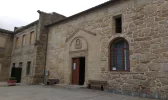

Was it this one? This is the municipal uphill from the old center.
View attachment 79516
And this is the Xunta:

Albergue de peregrinos de Ourense | Albergue de Peregrinos en Ourense | Gronze.com
Información del albergue de peregrinos Albergue de peregrinos de Ourense, en Ourense: Precio, plazas, características, etc...www.gronze.com
But maybe the person is the same...
PS (The municipal one is no longer listed on Gronze. Is it closed? Anybody knows?)
OK, puzzle solved. That was in "old" municipal albergue (Kelly is wrong here calling it Xunta run albergue) on Rua Pena Trevinca in the former monastery (now museum - next door to the left in my photo). There was quite tiny and dark lobby once you entered and a hospitalero booth with a sliding window. And the rude male was definitely the same. I really hope that the Xunta didn't hire him.This is an interesting puzzle. The address seems to fit what you call the municipal and Kelly calls the Xunta albergue, uphill from the Cathedral on the Rua Pena Trevinca on Kelly's map in his 2016 guide. I walked the VdlP in 2017. The second albergue which you show was opened in 2018, so cannot be part of my memories, and I do not recognize it at all. Perhaps the dark brown wood which I remember from the first albergue was on the inside, to fit the mood of the place. In any case, I stayed there on the 16th of November, 2017, and I remember it as quite dark.
Santa Comba de Bande — I don’t think this is near any camino (at least not any that I know of), but I once spent a glorious weekend in Galicia in that area and took the short drive from Celanova (a very pretty Galician town) to visit the church. And ruins of a Roman fort along the way. Celanova has its own monuments to visit, too!
I think his brother works in the Lugo albergue.That said, I would want to tar all the Xunta albergue hospitaleros and hospitaleras with the same brush. Some are good people with a lot of love for pilgrims. Sadly, the guy in Ourense isn't one of them.
If you have a full day in Orense
I would like to take this opportunity to mention two hospitaleras in Xunta albergues who went well beyond the call of duty to serve pilgrims. The first was a young woman in Hospital de la Condesa, where many pilgrims find themselves, having bypassed the O'Cebreiro Xunta albergue. On my last time through, many pilgrims had brought enough food to cook, but had the usual problem with no cooking utiensals at Xunta albergues. This young woman had brought a large pot from home for pilgrims to share to cook up a main dish for all those who chose to prepare their own food. I donated a metal cup and a spoon to one pilgrim, who had nothing to eat with, and went to eat at the local bar, where the food was even more atrocious than usual.I wouldn't want to tar all the Xunta albergue hospitaleros and hospitaleras with the same brush. Some are good people with a lot of love for pilgrims.
I am glad we made the decision to go to Allariz. We'll definitely consider the tour with Xeitura.If you do go to Allariz, you can get a really really nice tour out to Santa Mariña das Aguas with a small cultural company called Xeitura. Based on their upgraded website, their business has taken off since I was there a few years ago. Kanga took the tour and enjoyed it. Highly recommended, a great way to spend about 3 hours near Allariz.
After Seixalbo, we'll make sure we take the riverside walk into Ourense.Seixalbo is a delightful surprise - a pretty town with beautiful stone buildings and narrow streets. There are a couple of shops, including a nice panadeira with a sign welcoming pilgrims. I've never made it this far without taking a break at an earlier cafe, so I haven't ever stopped here, but I'm sure it would be nice to find a park or a square and sit down for a bit. It's tempting to think that you're virtually in Ourense at this point, but in fact, you still have a fair bit of walking through outskirts to go
One day will be enough this time. We'll have to come back, with a car, to discover the area as recommended by @peregrina2000 :Unless you have a specific interest in the museums or the Celtic sites, I think a day is enough. The area of historic interest is quite compact. Apart from the old town around the cathedral, the city lacks charm.
None of your trip reports are too long, @peregrina2000 ☺ Thank you!!!I would go further and recommend the Ourense areas as a great area to visit ancient sites and stunning scenery (the Sil River gorge). One long weekend several years ago, I took a long weekend trip from Lisbon and wrote up this trip report. It is too long (but you are used to that from me), but I hope the itinerary might be of use to anyone who is considering traveling around this lovely area. A car is definitely needed, though.
Glad you enjoy the seafood, but is there anything for vegetarians?I don’t remember AVE construction trucks on the road from Xunqueira, so I guess they finished their work around here. There is one hairy section of road between the Industrial estate and Seixalbo - a curved road where the cars and trucks move really fast. Not as narrow as some roads. Pedestrian area to the side is adequate. Visibility isn’t as bad as some places. But the vehicles go quite a bit faster than most roads that we walk along
That’s the one. I think it’s official name is the San Cibrao Poligono, which sullies the name of the nearby village of San Cibrao that I can see on the map. I’m glad you have the instructions for avoiding it.
It’s disappointing that the official Camino doesn’t divert pilgrims away from it. I am tempted to say that this is what happens in places where the Camino is a job for the regional office of tourism and culture rather than a vocation for a passionate enthusiast.
Unless you have a specific interest in the museums or the Celtic sites, I think a day is enough. The area of historic interest is quite compact. Apart from the old town around the cathedral, the city lacks charm. I have a more positive impression of it than does Peregrina2000 but I can see why she isn’t enthusiastic. That said, if you’re feeling beaten up and exhausted by the 800km of road behind you, then a couple of days of writing postcards at cafe tables and relaxing in the free municipal baths is a good way to recover. You’ve got a hill to climb when you leave Ourense, so you can justify that extra plate of prawns. The restaurants by the cathedral are tourist oriented with prices to match but the quality of the seafood is really good from here all the way to the coast.
Glad you enjoy the seafood, but is there anything for vegetarians?
According to Gronze, the route from Allariz avoids the industrial polygon, and does not converge at Pereiras, unless one wants to do a detour.The industrial bit that I would most like to avoid is shortly before Seixalbo. Unfortunately the route from Allariz and the route from Xunqueira converge at Pereiras, and then take you through the industrial “polygon”
I would like some pioneering soul to step off the official route before Pereiras - perhaps going through Veredo or Calvos - and plough a new furrow to Seixalbo for future pilgrims to follow.
We're leaving Ourense, @Raggy , after a day's rest. @C clearly is already way ahead, as she walked all the way to Oseira.Are we still in Ourense? I think I gave a description of the less steep route out of town (to the right) in the previous thread. Perhaps we can go the left way this time and I’ll take a back seat and enjoy the descriptions. (I’ve heard that there’s also an unofficial left way via the hot springs but I think it joins up with the main left way eventually).
es un espacio abierto a toda persona de buena voluntad que busque descanso para su alma y su cuerpo
The monastery at Oseira offers rooms in their hospederia to those who seek a spiritual retreat. A minimum of two nights is required, so when we walk this Camino in real life, we will consider this. There is no mention that it is restricted to men only:
Yes. Gronze’s map shows a route that Avoids the polygon - and this is definitely the way I would recommend.According to Gronze, the route from Allariz avoids the industrial polygon, and does not converge at Pereiras, unless one wants to do a detour.
It is precisely because we are going to avoid the region around A Castellana that we walked to Allariz. Hopefully we are not mistaken!

 vivecamino.com
vivecamino.com
At the risk of repeating myself, this is the area where the Galician sounded close to Portuguese to me. Why here and not earlier when we were closer to Portugal? Well, my guess is that people and pronunciations travel more easily in the tame, relatively flat, and well connected areas with navigable rivers, than they do across short distances in the wild, mountainous regions.If we go to the right, "por Tamallancos", we can stop at Tamallancos.
Day 65: Ourense to Tamallancos
@Raggy has indeed described the route to the right
Definitely! I'll be looking for GPX tracks, or at least have the area downloaded for maps.me to make sure I avoid going back up to Pereiras.I have no idea which way the arrows will direct you. I advise you to keep an eye on your gps and try to avoid the temptation of the covered rest area with seating for pilgrims.
We'll stay at Casa Mañoso.Cea itself is a lovely village. There used to be bakeries on every corner - Today, you can view the ruins of those beautiful stone buildings and the horreos. If you feel like stopping here instead of continuing to the monastery, I don't think you'll regret it.
It’s a pleasure after so much time in white bread country to find slices of nutty, grey, heavy bread accompanying your Caldo Gallego. You’ve probably been enjoying this kind of bread since you were in Ourense. And now you’ve reached the origin of Europe’s only bread to have a geographically controlled denomination. In the same way that wines can only carry the name of a region if they are produced in that region under the conditions (types of grape and production methods) that are covered by the denomination, so Pan de Cea must be made in Cea according to the traditions of the bakers to qualify as Pan de Cea. My guess is that bread produced with white flour in Cea would not be allowed to call itself Pan de Cea, even though it is indisputably bread from Cea. Perhaps it would be Pan a Cea, with miraculous healing powers:Day 66: Tamallancos to Cea
I would have gone out of my way for this had I known about it.
Off topic, but nearby. Does anybody remember the name of the Panaderia near Roderio the Spanish royal family gets their bread? For a fanatic, that might be worth a detour from the Sanabres.


If you want to try Pan de Cea you don't have to get out of the way because San Cristovo de Cea is right on the Sanabres.I would have gone out of my way for this had I known about it.
Off topic, but nearby. Does anybody remember the name of the Panaderia near Roderio the Spanish royal family gets their bread? For a fanatic, that might be worth a detour from the Sanabres.
Oops.Typo...and indeed, I knew that it's way out of the way.Rodeiro (not Roderio) is indeed off the Sanabres because it's on Invierno. And the panaderia is called Jesus
Jesus. An easy name to remember. Thanks Sabine and K1.Panaderia Jésus!
It even has its own website:It’s a pleasure after so much time in white bread country to find slices of nutty, grey, heavy bread accompanying your Caldo Gallego. You’ve probably been enjoying this kind of bread since you were in Ourense. And now you’ve reached the origin of Europe’s only bread to have a geographically controlled denomination. In the same way that wines can only carry the name of a region if they are produced in that region under the conditions (types of grape and production methods) that are covered by the denomination, so Pan de Cea must be made in Cea according to the traditions of the bakers to qualify as Pan de Cea.
Doable, certainly. It looks like we can walk from Cea to Oseira, and then to Rodeiro. So for us slow walkers, that would be two days, one of just under 9km (our Day 67 above), and then one of about 17km to Roderio. Finally, one day on the Invierno from Rodeiro to Lalín, 21.8km. So doable, even for slow walkersAny bread fanatic would tell you that kind of thing is worth a long detour.
And this one's only 25.6 kms from Cea, my map tells me. Hmmm. Cea-Rodeiro-Lalin...quite doable.
We're catching up, @Raggy .I can’t tell you anything about the road to Oseira or the monastery, so I expect I’ll catch up with you again somewhere around Lalin.
We might, in real life, stop at Castro Dozón from Oseira, and that would give us two short days. But I have tarried too long, we're getting close to the end.Enjoy the route through Oseira. I'll see you in Castro Dozon!
In Estación we'll stay at the Hostal A Taberna de Vento. Gronze makes no mention of an albergue, but @Raggy mentions it in @C clearly 's Sanabrés:I think it's in Castro Dozon that there's a bar with what looks like it used to be a supermarket at the back. If you inquire about food, the owner will apologize for not having any ... And then he will offer to throw together a sandwich or an omelet, which turns out to be absolutely perfect. made with ingredients from the store. I've had the identical experience twice - Perfectly pleasant but kind of odd.
In four days, stopping at places recommended in this Forum, we will be in SdC. Thank you for being patient with us slow walkers...Pilgrim accommodation in Estación de Lalin is in a big yellow building across the road from the Taberna A Vento, which is where you need to go to pick up the keys. It's not exactly "directly on" the camino as Bronze suggests, but as long as you go into the village, you can't miss it. The accommodation is quite comfortable - Best value if you're with friends is to share a basic room with multiple beds and a shared shower..
That may be an interesting alternative route and it would give you the chance to meet one of my favourite hospitaleros - Emiliano. The town is a modern, industrial town but I have a soft spot for it. The albergue is probably the best appointed albergue that I have ever stayed at. In addition to the things that delight pilgrims in other albergues (such as a washer and dryer), Emiliano’s place also boasts nice crockery, cutlery, cooking equipment, Nespresso machine in the kitchen; fan heaters in the bathroom to save you from ever feeling a chill on emerging from the shower; a lounge with a big TV and board games; new beds and renovated bedrooms with two or three bunk beds in each ... For an albergue on a not-so-popular route, it feels pretty fancy to me.Finally, one day on the Invierno from Rodeiro to Lalín, 21.8km. So doable, even for slow walkers
I stopped in estacion once and Lalin once. (My Castro Dozon comment was about where the two routes from Cea converge). I regret never visiting Oseira. I have always been with other pilgrims who were eager to reach the “goal” of Santiago at this point. Honestly, that’s a mistake. The region is pleasant and there are enough accommodation facilities to allow you to stop frequently and enjoy this gentle countryside.We’ll stop in Estación de Lalín, that's a 22.9km stage. I think you stopped in Castro Dozón,
Take your time. The Camino at this point gives you so many options - If you’re not constrained by deadlines, it should be a very enjoyable time.In four days, stopping at places recommended in this Forum, we will be in SdC. Thank you for being patient with us slow walkers...
Yes, I was blown away, too. It was very comfortable. And the pizza he makes in the shop up the street is super, too. I never needed the kitchen because of that.it would give you the chance to meet one of my favourite hospitaleros - Emiliano. The town is a modern, industrial town but I have a soft spot for it. The albergue is probably the best appointed albergue that I have ever stayed at. In addition to the things that delight pilgrims in other albergues (such as a washer and dryer), Emiliano’s place also boasts nice crockery, cutlery, cooking equipment, Nespresso machine in the kitchen; fan heaters in the bathroom to save you from ever feeling a chill on emerging from the shower; a lounge with a big TV and board games; new beds and renovated bedrooms with two or three bunk beds in each ... For an albergue on a not-so-popular route, it feels pretty fancy to me.
Is that in Rodeiro or Lalín?That may be an interesting alternative route and it would give you the chance to meet one of my favourite hospitaleros - Emiliano. The town is a modern, industrial town but I have a soft spot for it.
Lalin. @Raggy is talking about this albergue: https://www.gronze.com/galicia/pontevedra/lalin/albergue-lalin-centroIs that in Rodeiro or Lalín?
Yes!Lalin. @Raggy is talking about this albergue:
If you take a route via Cea and Rodeiro, I guess we'd better wish you Buen Panino.
We're not going to walk via Rodeiro on this virtual camino, so we're also not going to go through Lalín, which means that we're going to avoid the said debate.Note - I think there have been debates on some threads about whether the way out of Lalin is well waymarked. Some say it is. Some say it ain't. Let's not re-visit that issue here. Can someone just point to the relevant threads where this has been thoroughly discussed.
Everyone seems in a hurry to get to Santiago at this point, but with all the facilities after Estación de Lalin, there's no reason to rush ... I think if I were to do it again, I'd take three days to give myself an evening in Silleda ...
From Sevilla, we haven't been constrained by deadlines, and we have been trying to enjoy - disfrutar in Spanish - our Camino. So we're not in a hurry to get to SdC, and we're going to walk 15km to Silleda.Take your time. The Camino at this point gives you so many options - If you’re not constrained by deadlines, it should be a very enjoyable time.
I have a suggestion for Silleda. I stayed twice at Hotel Ramos: very comfortable and with pilgrim rates. They are open outside of the busy season, when albergues and other accommodation are closed. They were very helpful on my first visit, phoning ahead, so that I knew whether accommodation closer to Santiago was available. On my second visit, the receptionist decided that I needed a really nice room (for the usual pilgrim rate) and gave me a luxury room with a spacious bathtub. I had two baths, to soak out the stiffness. Heaven!


We're not going to walk via Rodeiro on this virtual camino, so we're also not going to go through Lalín, which means that we're going to avoid the said debate.
Day 69: Estación de Lalín to Silleda
From Sevilla, we haven't been constrained by deadlines, and we have been trying to enjoy - disfrutar in Spanish - our Camino. So we're not in a hurry to get to SdC, and we're going to walk 15km to Silleda.
@C clearly walked through A Laxe and then further, so I won't get any advice on where to stay in Silleda from her virtual Camino. There shouldn't be any problem with choice, though, so we could go with two recommendations in Gerald Kelly's guide, either Hostal Gonzales, which is now called Hostal Bluû, or Casa Nova. Obviously, we're open to any other recommendation
Gerald Kelly also recommends Café Bar Maril and A Bodeguilla for meals.
Check out the church of Santiago in Trasfontao. I believe the pilgrim office in SDC gives bonus brownie points for credentials with lots of santiago stamps.Day 69: Estación de Lalín to Silleda
Here:Can someone just point to the relevant threads where this has been thoroughly discussed.


